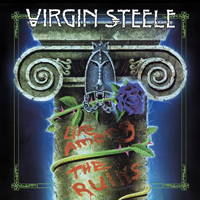Can anyone explain to me the appeal of re-releasing older material again? I can understand a band releasing a landmark album, or its entire back catalogue to help bolster sales and perhaps commemorate a certain period of musical![]() greatness. I can also buy the idea of re-releases to meet the demanding needs of the fans that support the band, but I don’t fathom how an album like Virgin Steele’s Life Among the Ruins is getting this said treatment.
greatness. I can also buy the idea of re-releases to meet the demanding needs of the fans that support the band, but I don’t fathom how an album like Virgin Steele’s Life Among the Ruins is getting this said treatment.
It’s not a bad album overall, but for my tastes it doesn’t hold up as well to previous entries like Age of Consent or Noble Savage. Both releases were hard driven epics, but by the time they came to recording Life Among the Ruins, the band switched their style to bluesy hard rock. Originally released in 1993, many of the songs![]() on this recording feel like they could have been discarded songs from Whitesnake, what with the large number of ballads steering the music away from their metallic edge of the past.
on this recording feel like they could have been discarded songs from Whitesnake, what with the large number of ballads steering the music away from their metallic edge of the past.
Life Among the Ruins was the fifth studio effort recorded by the band and it was also the first album for newly-minted bassist Rob DeMartino, who replaced the retiring Joey O’Reilly. At least in this new form, the recording is getting the digi-pak treatment and contains a second disc loaded with extras. So for anyone who digs supplemental material, then this might be the re-release for you. In addition, the original recordings were all re-mastered, and repackaged with copious liner notes, and photos.
With all that being said, is this album actually any good? Well rest assured it has a few solid tracks bolstered by singer![]() David DeFeis’s powerful vocals. Despite the stylistic change in sound, he still delivers a standout metal performance throughout the album. I found the music lacking a bit though, but the good production helps to this keep this from being a total lost cause. If anything, this release illustrates a band willing to expand into a broader spectrum of music.
David DeFeis’s powerful vocals. Despite the stylistic change in sound, he still delivers a standout metal performance throughout the album. I found the music lacking a bit though, but the good production helps to this keep this from being a total lost cause. If anything, this release illustrates a band willing to expand into a broader spectrum of music.
Perhaps this is ultimately the point behind re-releasing the album again. For a brief period, the epic and powerful style forged by these rock gods went away and what we were left with was Def Leppard laced ballads simmering with glam rock attitude. Surely this was a bump in the road, and I dare say this might even be equivalent to Celtic Frost’s Cold Lake phase. Luckily though, the release didn’t bury them because they followed this up with the stellar The Marriage Of Heaven & Hell: Part 1 a year later.
So if you are brave![]() enough to revisit this period of Virgin Steele’s existence, and you want to be swayed by their softer approach to songwriting then give this a try. If not, then skip it and seek out the epic sounding nature of later releases.
enough to revisit this period of Virgin Steele’s existence, and you want to be swayed by their softer approach to songwriting then give this a try. If not, then skip it and seek out the epic sounding nature of later releases.
(This content originally appeared on Blistering.com)


